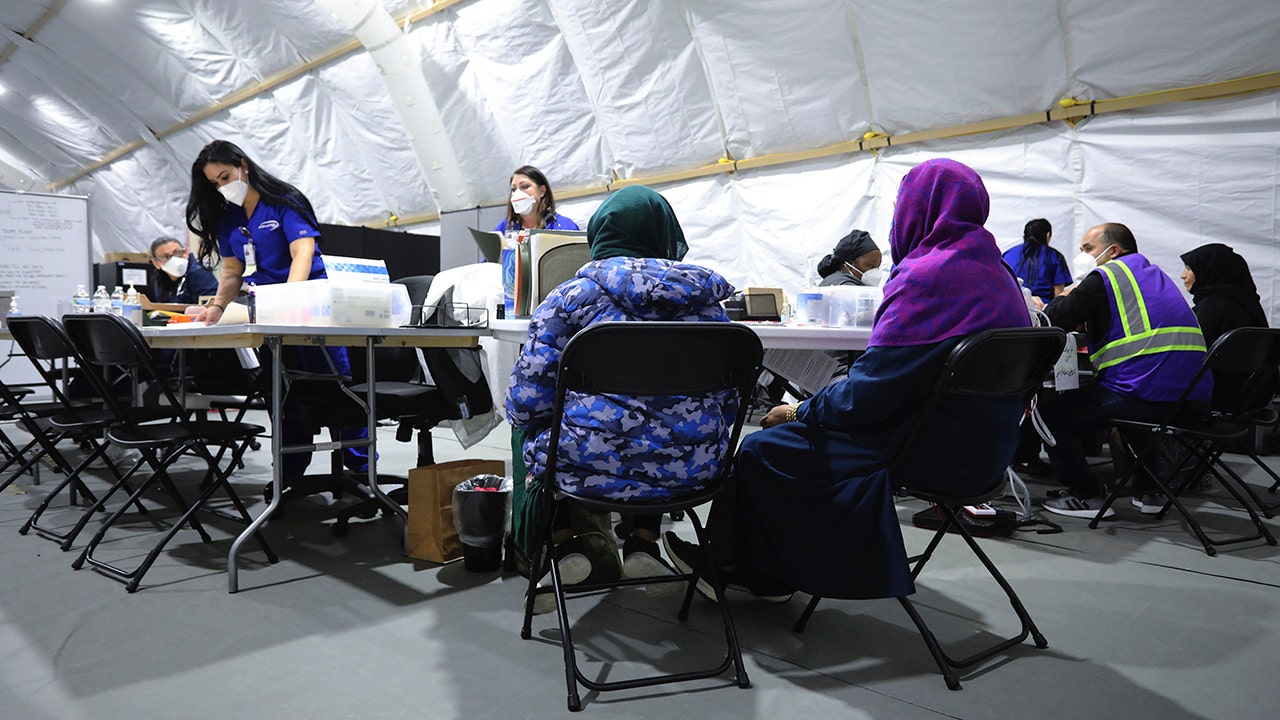
A new Department of Defense (DOD) report found that the U.S. military bases that housed Afghan evacuees suffered $260 million in damages, with the Air Force saying the damage was ‘unrepairable.’
The DOD inspector general reported last week that the eight bases housing the refugees in Texas, Wisconsin, New Jersey, Virginia, New Mexico and Indiana are asking for repair money after they sustained over a quarter-billion dollars in damage.
Over 17 days, 120,000 evacuees were taken to the U.S. amid the deadly, botched withdrawal that saw Afghanistan fall under Taliban control.
‘A description of the damages from Air Force officials explained that the damage by guests was unrepairable,’ the Pentagon report reads.
‘Air Force officials described tables, chairs, and cots broken by guests and tents and cots ruined by spray paint, human biological matter, and holes,’ it continues.
‘The Air Force described materials as ‘completely depleted, such that no materials remain available for other real world missions,’’ it adds.
Some of the damage to the buildings left them unusable for the military until the plumbing and walls are repaired.
‘DoD installations reported that facilities and equipment were overused, damaged, and remained in various degrees of disrepair, resulting in a costly maintenance effort,’ the report reads.
‘DoD installations need to restore their facilities and equipment to a condition that enables them to conduct trainings, prepare for future events, and return to normal base operations,’ it continues.
Some bases requested more money from the DOD than others. Fort Bliss in Texas, which housed 11,472 migrants, only asked for over half a million dollars in repair costs while Fort McCoy in Wisconsin — which housed nearly the same number of refugees — asked for $145.6 million.
The DOD inspector general also raised questions about whether the money was solely being asked for repairs connected to housing evacuees.
In September, amid the system shock from the sheer number of evacuees headed to the U.S. from Afghanistan, the U.S. State Department, working with humanitarian organizations, turned to ordinary Americans to fill the gap. Neighbors, co-workers, faith groups and friends banded together in ‘sponsor circles’ to help Afghans get settled in their communities.
They raised money and found the newcomers homes to rent, enrolled their children in schools, taught them how to open bank accounts and located the nearest mosques and stores selling halal meat.
Now the Biden administration is preparing to turn the experiment into a private-sponsorship program for refugees admitted through the U.S. Refugee Admissions Program and is asking organizations to team up with it to launch a pilot program by the end of 2022.
The move comes amid increasing pressure on President Joe Biden, who vowed in a 2021 executive order to increase opportunities for Americans to resettle refugees and restore the U.S. as the world’s safe haven. The Trump administration decimated the refugee program, which traditionally tasks nine resettlement agencies with placing refugees in communities.
The Associated Press contributed reporting.

A new Department of Defense (DOD) report found that the U.S. military bases that housed Afghan evacuees suffered $260 million in damages, with the Air Force saying the damage was ‘unrepairable.’
The DOD inspector general reported last week that the eight bases housing the refugees in Texas, Wisconsin, New Jersey, Virginia, New Mexico and Indiana are asking for repair money after they sustained over a quarter-billion dollars in damage.
Over 17 days, 120,000 evacuees were taken to the U.S. amid the deadly, botched withdrawal that saw Afghanistan fall under Taliban control.
‘A description of the damages from Air Force officials explained that the damage by guests was unrepairable,’ the Pentagon report reads.
‘Air Force officials described tables, chairs, and cots broken by guests and tents and cots ruined by spray paint, human biological matter, and holes,’ it continues.
‘The Air Force described materials as ‘completely depleted, such that no materials remain available for other real world missions,’’ it adds.
Some of the damage to the buildings left them unusable for the military until the plumbing and walls are repaired.
‘DoD installations reported that facilities and equipment were overused, damaged, and remained in various degrees of disrepair, resulting in a costly maintenance effort,’ the report reads.
‘DoD installations need to restore their facilities and equipment to a condition that enables them to conduct trainings, prepare for future events, and return to normal base operations,’ it continues.
Some bases requested more money from the DOD than others. Fort Bliss in Texas, which housed 11,472 migrants, only asked for over half a million dollars in repair costs while Fort McCoy in Wisconsin — which housed nearly the same number of refugees — asked for $145.6 million.
The DOD inspector general also raised questions about whether the money was solely being asked for repairs connected to housing evacuees.
In September, amid the system shock from the sheer number of evacuees headed to the U.S. from Afghanistan, the U.S. State Department, working with humanitarian organizations, turned to ordinary Americans to fill the gap. Neighbors, co-workers, faith groups and friends banded together in ‘sponsor circles’ to help Afghans get settled in their communities.
They raised money and found the newcomers homes to rent, enrolled their children in schools, taught them how to open bank accounts and located the nearest mosques and stores selling halal meat.
Now the Biden administration is preparing to turn the experiment into a private-sponsorship program for refugees admitted through the U.S. Refugee Admissions Program and is asking organizations to team up with it to launch a pilot program by the end of 2022.
The move comes amid increasing pressure on President Joe Biden, who vowed in a 2021 executive order to increase opportunities for Americans to resettle refugees and restore the U.S. as the world’s safe haven. The Trump administration decimated the refugee program, which traditionally tasks nine resettlement agencies with placing refugees in communities.
The Associated Press contributed reporting.
















